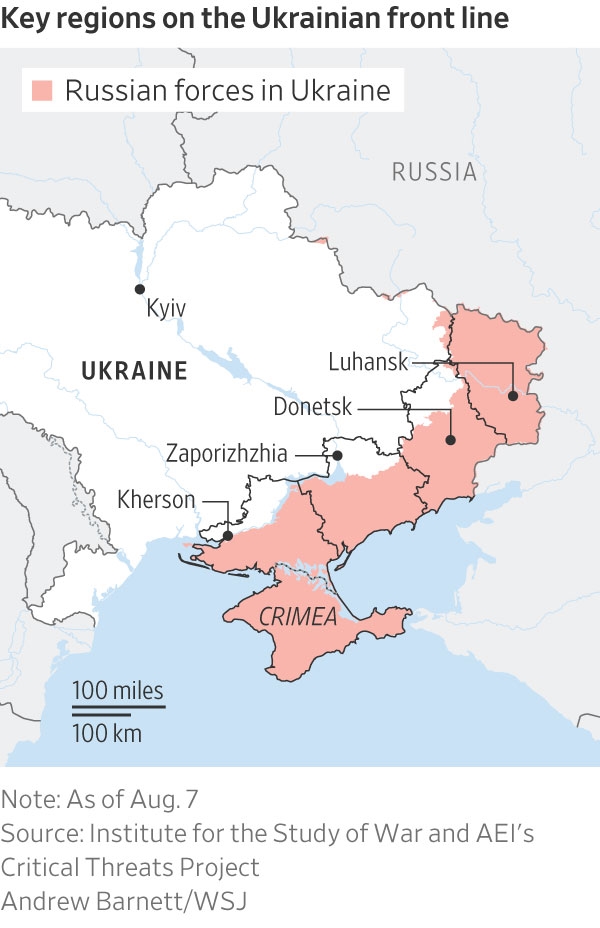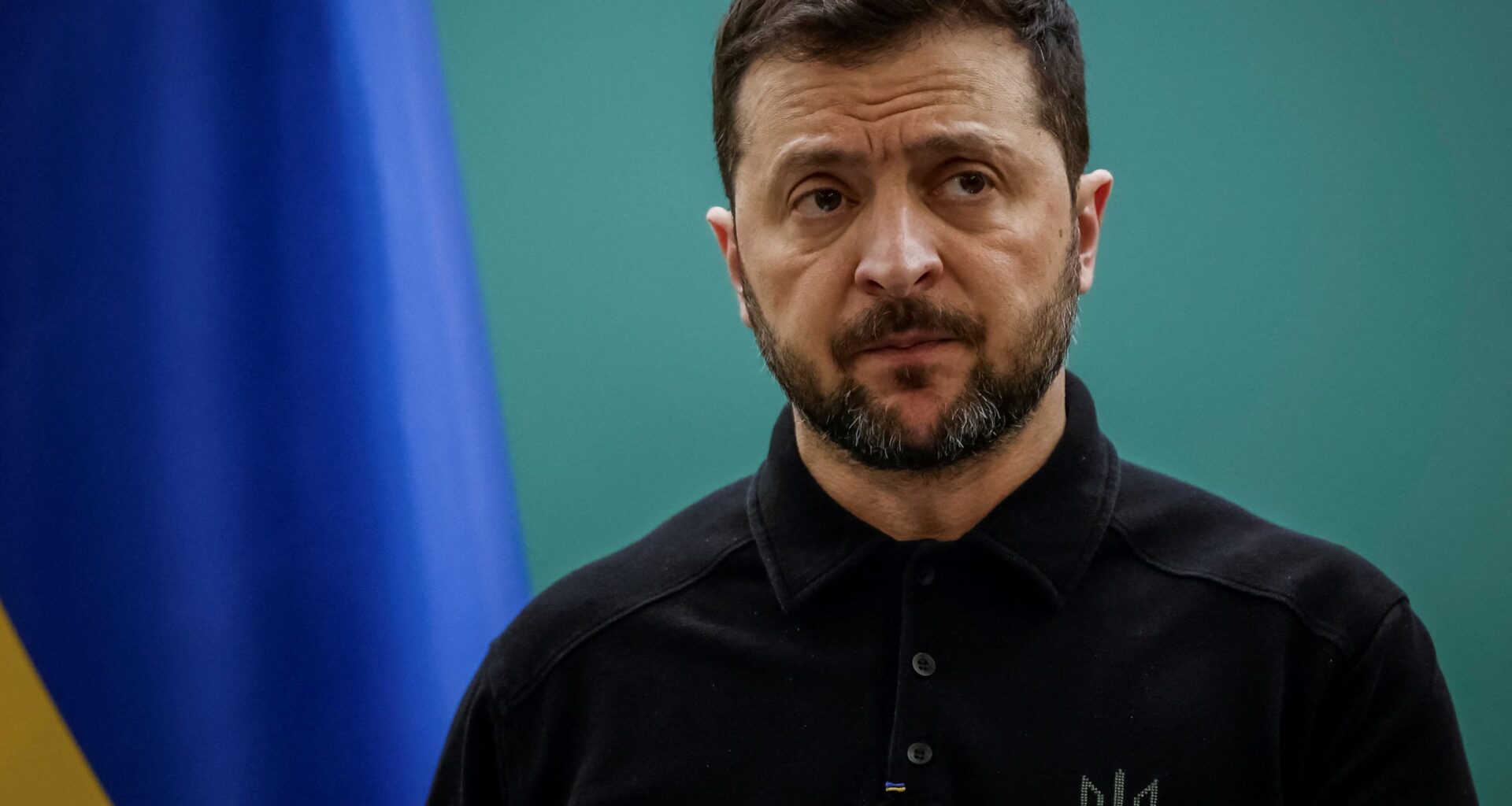BERLIN—European powers and Ukraine responded to Vladimir Putin’s cease-fire plan with a counterproposal that they say must serve as a framework so that coming talks between President Trump and the Russian leader can gain traction, according to European officials familiar with the talks.
The European plan rejected a Russian proposal to trade Ukrainian-held parts of the Donetsk region for a cease-fire. It was put forward in a meeting with top U.S. officials in England on Saturday.
The meeting was constructive, Ukrainian President Volodymyr Zelensky said Saturday night. “Our arguments are being heard. The dangers are being taken into account,” Zelensky said in an address.
“It’s important that America has the determination and capability to end the war, and we welcome President Trump’s efforts to stop the killing,” he added.
A U.S. official said the meetings made progress toward Trump’s goal of ending the war in Ukraine. A European participant said the U.S. side reacted positively to the European plan.
European governments including those of Britain, Germany and France, as well as Ukraine, scrambled to respond to the peace proposal that came out of this past week’s encounter between Putin and U.S. special envoy Steve Witkoff at the Kremlin. Following these talks, Trump let lapse his self-imposed deadline for imposing stiff secondary sanctions on Russia and agreed to a summit with Putin in Alaska on Aug. 15.
The European aim is to draw a common red line together with Ukraine that European officials say must apply to any potential negotiation with Russia.
“The future of Ukraine cannot be decided without the Ukrainians who have been fighting for their freedom and security for over three years now,” French President Emmanuel Macron posted on social media Saturday. “Europeans will also necessarily be part of the solution, as it concerns their security.”
The European proposal includes demands that a cease-fire take place before any other steps are taken. It also says that territory can be exchanged only in a reciprocal manner—meaning that if Ukraine pulls out of some regions, Russia must withdraw from others.
Crucially, the European plan, which was presented to Vice President JD Vance , Secretary of State Marco Rubio , Trump’s Ukraine envoy Keith Kellogg and Witkoff, also stipulates that any territorial concession by Kyiv must be safeguarded by ironclad security guarantees—including potential NATO membership for Ukraine.
Finland’s President Alexander Stubb called Trump to present the European initiative on Saturday afternoon.
“Europe stands united with Ukraine,” Stubb posted on social media. “We will continue to work closely with President Trump and the United States.”
The meeting was an important step forward, he added.
“A fragile cease-fire would only serve the Russians, cementing their conquests and curbing Ukraine’s chances to fight back,” European Union foreign-policy chief Kaja Kallas said in a message to European officials after the meeting.
The European plan was drafted and presented to the U.S. side by chief aides to European leaders. Vance was present at the meeting, while most other U.S. officials attended via a video link.
According to officials briefed on the proposal brought by Witkoff from Moscow, Putin has said he would agree to a cease-fire in exchange for Ukraine handing over roughly one-third of the eastern Donetsk region that Kyiv still controls. The front line would be frozen elsewhere, including in the Zaporizhzhia and Kherson regions that Russia also claims as its own.

Several European officials briefed on the Wednesday meeting with Witkoff noted that Putin didn’t repeat his original, more hard-line position: that Ukraine must be demilitarized and its government replaced, and that all of Kherson and Zaporizhzhia, regions whose capitals are controlled by Ukraine, should be ceded to Russia. Putin annexed these three regions and a fourth, Luhansk, which is nearly fully occupied by Moscow, after sham referendums in 2022.
Some of the European officials said Saturday that if Ukraine were to hand over the entire Donetsk region, Russia would have to withdraw from the occupied parts of Zaporizhzhia and Kherson in the south.
The plan shocked Zelensky, who hasn’t been invited to Alaska, and European leaders. He described it, following Saturday’s conversation with U.K. Prime Minister Keir Starmer , as “a plan to reduce everything to discussing the impossible,” and said that Ukraine wouldn’t give its land to anyone.
A senior aide to a European leader said it was regrettable that Putin managed to avert the punitive measures scheduled by Trump that would have severely hurt Russia’s war economy and diminished its ability to escalate its invasion of Ukraine. Putin showed how vulnerable he was to U.S. pressure and Trump must use his leverage, the official said.
Any agreement Trump and Putin reach in Alaska wouldn’t be worth much without the participation of European leaders, another senior European official said.
In their meeting with Vance, European officials reiterated that the future of Ukraine can’t be discussed without Ukraine. No matter what happens in Washington, Europe will continue providing Ukraine with weapons and funds, one senior European official said.
Russia has been on the offensive for more than two years, and in that time conquered less than 1% of Ukrainian territory, much of it in the Donetsk region, while losing hundreds of thousands of troops in pitched fighting dominated by brutal drone warfare.
Embroiled in battles for the towns of Pokrovsk and Chasiv Yar since early last year, the Russian army is unlikely to seize the heavily fortified agglomerations of Slovyansk and Kramatorsk in the north of the Donetsk region anytime soon, according to most military analysts.
Handing over this strategic terrain, home to hundreds of thousands of Ukrainian citizens, in exchange for a cease-fire would mean that Putin, who has broken multiple cease-fires in the past, would be getting a windfall in exchange for giving nothing, said European officials from three countries involved in the talks.
The European counterproposal comes after a week of frantic diplomacy triggered by Putin’s overture to Witkoff. Hours after the two men met at the Kremlin, Trump summoned a call with select European leaders and Zelensky to brief them on the proposal.
On the call, Trump suggested that Russia would be ready to withdraw from the southern region of Zaporizhzhia and Kherson in exchange for full control of Donetsk, according to European officials from three countries familiar with that conversation and two subsequent calls.
However, Witkoff walked back that claim the next day in a call with the chief aides of European leaders, suggesting that Russia would both withdraw and freeze the front line.
On Friday, European officials demanded a third call with Witkoff to clarify the confusion about what Putin had proposed. In that call, Witkoff said that the only offer on the table was for Ukraine to withdraw unilaterally from Donetsk in exchange for a cease-fire. That proposal was rejected by both Zelensky and European officials involved in the talks.
Write to Bojan Pancevski at bojan.pancevski@wsj.com and Yaroslav Trofimov at yaroslav.trofimov@wsj.com
